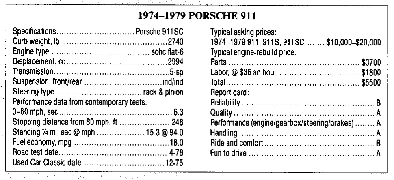 | 330 GT Registry |  |
1974-1979
Porsche
911
I CALL them “Porsche Muslims” because each day they face east and pray toward Zuffenhausen. This year a whole congregation of them descended upon our quiet hamlet for a week of intensive praise. They came to Newport Beach for the 30th Porsche Parade and Concours d’Elegance, 1100 officially registered worshippers from 32 states and 16 countries.
Just what car is it that inspires such religious fervor? Primarily the Porsche 911, a car that takes to the curves like a Bavarian takes to beer. Most Porsche owners know that a 911 is closer than almost any other production car to a racing machine.
I should mention, however, that the 911’s predecessors, the 356-series cars, are objects of cult worship too. In fact, we nearly selected one of the most endearing examples of that series, the Speedster of the late Fifties, as one oft his year’s bargain bests, But we discovered an interesting phenomenon in the market that eliminated it from consideration. There are plenty of Speedsters around for considerably less than $20,000, but they tend to be doggy. The nice ones all seem to sell for $25,000 or more, usually because they’ve been restored. There’s just not much in between.
Now back to the 911. The car is one of the most remarkable designs in automotive history, if for no other reason than its staying power. Making its debut at the Frankfurt auto show in 1963, the 911 is the oldest design of any sports car currently sold new in the U.S. Yet buyers still eagerly snap up every one the factory builds. The car s attraction isn't merely based on some nostalgia factor either. Porsche has always managed to keep the 911 a few paces ahead of its modern competitors.
What’s all the more remarkable is that the basic layout of the 911, with its air-cooled and rear-mounted engine, stacks the deck against the car’s success.
The layout presents all sorts of inherent quirks, including tricky handling characteristics and a high level of noise. But with constant and often clever development, the 911 has managed gracefully to meet all the U S emissions and safety regulations that were nothing but a gleam in the eyes of bureaucrats when the car was de signed. And just as important to driving enthusiasts, Porsche has managed to meet the regulations and alleviate the car’s inherent deficiencies at the same time. The transient oversteer remains, but few drivers will ever exceed the handling limits of a more recent 911 because those limits seem to get higher as the years pass. The raspy staccato wraaaaaa of the engine, guaranteed to annoy the neighbors, has even been quieted. Though all 911s are basically alike, later examples are, if any thing, more exciting to drive and more practical for everyday use.
All this goodness doesn’t come cheap, of course, with 1985 911s in the $35,000 range. But here’s the best news: For about half that, you can have a 1978 or 1979 911 SC, and only one of the most devout Porsche worshippers could easily distinguish a 911SC from a brand-new model. Or, for little more than $10,000 you can buy a 1974 911 which, with its beefy bumpers, also looks similar to a new 911.
So within the $10,000 to $20,000 price range. 1974 through 1979 911s comfortably fit. But Porsche experts tell us the 1975, 1976 and 1977 models had a few problems with excessive engine wear and oil leaks, making them a little less desirable than earlier cars, and much less desirable than the 1978 or 1979 cars, the first years of the SC model.
The difficulties came from heat, a by product of air pumps and thermal reactors added to meet emissions standards. The SC’s engine was bumped to 3.0 liters from the previous years’ 2.7. At the same time, catalytic converters replaced the thermal reactors, the engine cases were made of a different alloy, and the majority of 911SCs received front-mounted oil coolers. The changes corrected the problems and the 911SC continued to be an out standing performer With 0—60-mph times in the 6.0-sec range. Moreover, the 3.0- liter engine gives plenty of low-end torque, making it much more tractable when slogging through traffic.
Of course, 911s are known far and wide for their tendency to turn into heaps of iron oxide. But because we’re discussing here Porsches of a fairly recent vintage, rust won’t usually be a great concern, though you shouldn’t ignore it when you’re shopping for any used 911.

ROAD & TRACK October 1985
Copyright 1985, CBS, Inc.
